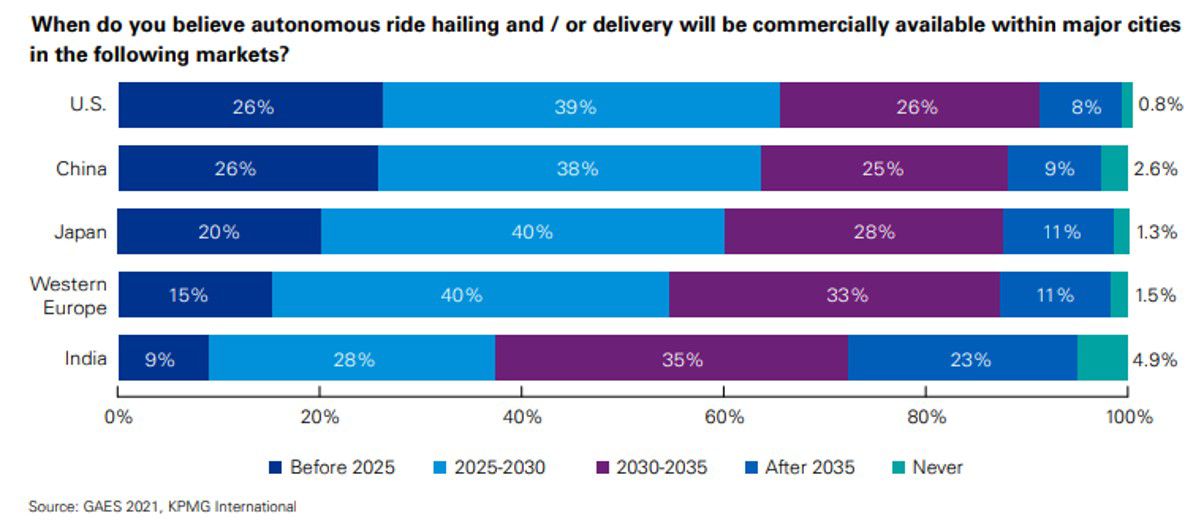The fifth edition of KPMG China’s Leading Autotech 50 report was launched at the end of 2021. The series continues to showcase China’s advanced automotive technology companies and their technologies and innovations. The report is divided into four categories: Innovative Services, Autonomous, Electric, and Connected. After several rounds of interviews and evaluations, the Innovative Services category was added to this latest edition.
This year, companies that have been recognised include selected leading and emerging companies in ride hailing, the automotive aftermarket, logistics and other B2B services. The ecosystem of innovative service companies in China continues to grow and they are directing their innovations towards drivers, passengers, logistics operators and OEMs. With the industry moving more towards technology-centric business models – such as subscriptions and on-demand services – new competitors are developing solutions for this rapidly growing segment.
KPMG China Leading Autotech 50 Company List – 5th Edition
Service Innovation Category
| Leading Company | |||
|---|---|---|---|
| CAOCAO | DAS MASTER | Jumeng | KZMALL |
| Data Enlighten | Newlink | T3 | Log56.com |
| SAIC Mobility | Ncarzone | SORL | |
| Emerging Company | |||
| PilotD Automotive | Tsing-Standard | Qiyu Cloud | StarRides |
* Companies are arranged in alphabetical order based on their Chinese pinyin names. Click on company names for more information.
Ride hailing market has become more dynamic amid regulatory changes
According to the 2021 KPMG Global Automotive Executive Survey (GAES), 71% of respondents from China believe that more or the same level of people will travel via taxis or ride hailing services compared to pre-COVID. In the US, 69% of executives have the same point of view, suggesting continued growth potential in the two largest ride hailing markets.
New opportunities for both ride hailing operators and new entrants have emerged in China from the second half of 2021. New policies on listing requirements and data privacy have served to enhance competition in the market and challenged the monopolies held by dominant players in regions across the country. As such, funding for companies has been revitalised and user signups on competing platforms have risen. Data from the Ministry of Transport shows 258 Chinese companies have obtained the business license required for ride-sharing services by the end of 2021. While pricing remains the key competitive element in ride hailing, additional features that companies are using to differentiate themselves include enhanced user experience, transparent customer data usage and regular data security assessments.
Ride hailing drivers are increasingly active in lobbying for a better treatment by platform operators and have begun forming unions to promote equitable treatment, increases in benefits and competitive wages. This is requiring companies to think sustainably about their workforce and provides another opportunity for differentiation.
Compliance, employee management, service quality and price will become the key success factors for competitors in this area, particularly as companies shift to the next phase of providing robotaxi services.
Advances in testing capabilities for autonomous vehicles will be required to meet market demand
In the 2021 KPMG GAES survey, most automotive executives believe that autonomous ride hailing or deliveries will become commercially available within major cities in the US, China, Japan and Western Europe by 2030. To address this market demand, increasingly advanced vehicles need to be developed and tested before they are made available to ride hailing fleet operators.

Currently, vehicles undergo careful manual testing under a variety of laboratory and real-life scenarios. The government remains committed to being a global leader in autonomous driving and supports the testing of autonomous vehicles. According to the Ministry of Transport, as of August 2021, 16 autonomous driving test demonstration zones have been built in China, more than 3500 kilometers of test roads have been opened, and more than 700 test licenses have been issued.
Despite these developments, the number of tests required for fully autonomous vehicles is several orders of magnitude higher when compared to conventional vehicles. The result: an impractical number of scenarios to test using conventional methods. While many of these testing scenarios and the corresponding response by the vehicle can be simulated virtually, physical testing is still required for thousands of scenarios. Autonomous testing platforms –which simulate real-life conditions in extreme or emergency scenarios – will be the next frontier for the development of autonomous driving technology. Technology companies in this area will provide OEMs and suppliers with flexible platforms and screens to aid in the development of sensors and algorithms.
More information on autonomous driving in China will be available in the next edition of the KPMG Autotech 50 special report.
The automotive aftermarket is undergoing a transformation ahead of the arrival of the EV era
According to data from the Ministry of Public Security, there are 302 million registered vehicles in China as of the end of 2021. Vehicle maintenance, repairs and insurance are the largest contributors to the total cost of car ownership and have proven resistant to innovation. Traditional repair shops have been hampered by problems such as low efficiency of product supply, high dependence on labour and inconsistent operational standards. To consolidate and upgrade independent service centres, leading repair companies are promoting digital development and data interchange between locations. This digitisation of operations also includes integration with partners such as insurance providers and parts suppliers. These companies can provide smart quotations for accident repair, digital financial analysis and timely inventory management to improve both operational efficiency and customer satisfaction.
According to the China Banking and Insurance Regulatory Commission, there are more than 550 million active automotive insurance policies in 2021. Servicing these insurance policies and the associated insurance claims is time-consuming and prone to error. Loss assessment supported by technology and remote support allows for more automotive insurance cases to be handled online without a visual inspection by an insurance agent. Innovative companies active in this space are focusing on using artificial intelligence and machine learning to improve damage assessment processes using minimal human intervention.
Commercial logistics
China’s foreign trade surplus hit a record high in 2021. The annual import and export of goods reached CNY 39.1 trillion. Imports increased by 21.5 percent, while exports advanced by 21.2 percent. This was driven by strong demand for Chinese manufactured goods due to COVID-19 and a policy-driven rise in domestic consumption. Both increases have driven improvements within the domestic logistics sector, particularly for commercial trucking. Technology companies have stepped in to address some of the most complex problems: consolidating the allocation of vehicles and drivers; improvements in track and trace services; and network optimisation to handle over 100 billion parcels that are sent in China annually. Innovative freight forwarding networks are helping to integrate fragmented orders, track deliveries in real-time and stabilise operations.
Sales channel innovation
Direct sales models and centralised lead generation continue to become more mainstream. Successful examples by new entrants in the new energy vehicle (NEV) market are accelerating the digitisation of the new vehicle sales process. In the 2021 GAES survey, 80% of Chinese executives surveyed believe that most new vehicle purchases (excluding test drives) will be completed online by 2030. Managing customers throughout the sales cycle will require the development of new skillsets for OEMs and new partnership opportunities for emerging players. With a growing used-car market, these platform players could provide another opportunity to engage with customers and promote a certified pre-owned vehicle (CPO) program on behalf of car makers.
Successful new entrants in this area will have a strong understanding of popular digital channels, cultural and demographic trends, deep automotive sales experience and awareness of the pain points that exist in both the current dealership and direct sales models. These agency-like players may also act as a new critical link in the long-standing and profitable relationship between advertisers and car makers.
Connect with us
- Find office locations kpmg.findOfficeLocations
- kpmg.emailUs
- Social media @ KPMG kpmg.socialMedia

